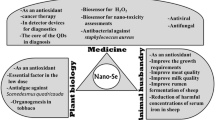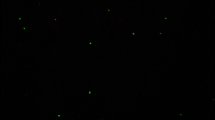Abstract
Living cells interact with different forms of metal; the resulted biochemical alteration depends on the dose. Over an average dose in ionic form, metals interact with respiration processes at various levels, and it induces oxidative stress by shifting the whole oxydoreduction equilibrium. To correct the toxicity, cell develops different ways to cancel the effect of the exceeded charges, and it reduces the ion to get a more stable form. In the case of nanoparticles, the reactivity of surface has been enhanced that can alter the biological mechanisms; the cell may develop different strategies to minimize this reactivity. The current study is focused on the pursuing of cell behavior regarding the presence of nanoparticles and their associated metals. Nanoparticles have been synthesized using bio-reducing agents and then were structurally characterized using X-ray diffraction, UV–Vis, and infra-red spectroscopy. The oxydoreduction flexibility of the post-synthesis modified nanoparticles was tested in vitro. Interactions with cells were done using Salmonella under various respiration conditions. The final results show the possible correction of oxidative stress effects and the recuperation of respiration.











Similar content being viewed by others
References
Makarov VV, Love OV, Sinitsyna AJ, Makarova SS, Yaminsky IV, Taliansky ME, Kalinina NO (2014) “Green” nanotechnologies: synthesis of metal nanoparticles using plants. Acta Nat 6(1):35–44
Iravani S (2011) Green synthesis of metal nanoparticles using plants. Green Chem 13:2638–2650. doi:10.1039/C1GC15386B
Ahmed S, Saifullah Ahmad M, Swami BL, Ikram S (2015) Green synthesis of silver nanoparticles using Azadirachta indica aqueous leaf extract. J Radiat Res Appl Sci. doi:10.1016/j.jrras.2015.06.006
Akhtar MS, Panwar J, Yun Y-S (2013) Biogenic synthesis of metallic nanoparticles by plant extracts. ACS Sustain Chem Eng 1:591–602. doi:10.1021/sc300118u
Oluwaniyi OO, Adegoke HI, Adesuji ET, Alabi AB, Bodede SO, Labulo AH, Oseghale CO (2015) Biosynthesis of silver nanoparticles using aqueous leaf extract of Thevetia peruviana Juss and its antimicrobial activities. Appl Nanosci. doi:10.1007/s13204-015-0505-8
Metz KM, Sanders SE, Pender JP, Dix MR, Hinds DT, Quinn SJ, Ward AD, Duffy P, Cullen RJ, Colavita PE (2015) Green synthesis of metal nanoparticles via natural extracts: the biogenic nanoparticle corona and its effects on reactivity. ACS Sustain Chem Eng 3(7):1610–1617. doi:10.1021/acssuschemeng.5b00304
Ibrahim HMM (2015) Green synthesis and characterization of silver nanoparticles using banana peel extract and their antimicrobial activity against representative microorganisms. J Radiat Res Appl Sci 8:265–275. doi:10.1016/j.jrras.2015.01.007
Ivask A, Kurvet I, Kasemets K, Blinova I, Aruoja V, Suppi S, Vija H, Käkinen A, Titma T, Heinlaan M, Visnapuu M, Koller D, Kisand V, Kahru A (2014) Size-dependent toxicity of silver nanoparticles to bacteria, yeast, algae, crustaceans and mammalian cells in vitro. PLoS One 9(7):e102108. doi:10.1371/journal.pone.0102108
Seabra AB, Durán N (2015) Nanotoxicology of metal oxide nanoparticles. Metals 5:934–975. doi:10.3390/met5020934
Maurer-Jones MA, Gunsolus IL, Meyer BM, Christenson CJ, Haynes CL (2013) Impact of TiO2 nanoparticles on growth, biofilm formation, and flavin secretion in Shewanella oneidensis. Anal Chem 85(12):5810–5818. doi:10.1021/ac400486u
Haddad PS, Seabra AB (2012) Biomedical applications of magnetic nanoparticles. In: Martinez AI (ed) Iron oxides: structure, properties and applications, vol 1. Nova Science Publishers Inc, New York, pp 165–188
Wu X, Zhao F, Rahunen N, Varcoe JR, Avignone-Rossa C, Thumser AE, Slade RCT (2011) A role for microbial palladium nanoparticles in extracellular electron transfer. Angew Chem Int Ed 50:427–430. doi:10.1002/anie.201002951
Giustini AJ, Petryk AA, Cassim SM, Tate JA, Baker I, Hoopes PJ (2010) Magnetic nanoparticle hyperthermia in cancer treatment. Nano Life. doi:10.1142/S1793984410000067
Weber KA, Achenbach LA, Coates JD (2006) Microorganisms pumping iron: anaerobic microbial iron oxidation and reduction. Nat Rev Microbiol 4:752–764. doi:10.1038/nrmicro1490
Hidouri S, Messaoudi N, Mihoub M, Baccar ZM, Landoulsi A (2015) Development of bio-hybrid material based on Salmonella typhimurium and layered double hydroxides. Afr J Biotechnol 14 (accepted)
Ensibi C, Lahbib K, Mrabet C, Daly Yahia MN (2015) Antioxidant activity of Aplysia depilans ink collected from Bizerte Channel (NE Tunisia). Algerian J Nat Products 3(1):138–145
Mihoub M, El May A, Aloui A, Chatti A, Landoulssi A (2012) Effects of static magnetic fields on growth and membrane lipid composition of Salmonella typhimurium wild-type and dam mutant strains. Int J Food Microbiol 157:259–266. doi:10.1016/j.ijfoodmicro.2012.05.017
Khazri A, Sellami B, Dellali M, Corcellas C, Eljarrat E, Barceló D, Mahmoudi E (2015) Acute toxicity of cypermethrin on the freshwater mussel Unio gibbus. Ecotoxicol Environ Saf 115:62–66. doi:10.1016/j.ecoenv.2015.01.028
Aebi H (1974) Catalase. In: Bergmeyer HU (ed) Methods of enzymatic analysis. Academic Press, London, pp 671–684
Ni W, Trelease RN, Eising R (1990) Two temporally synthesized charge subunits interact to form the five isoforms of cottonseed (Gossypium hirsutum) catalase. Biochem J 269:233–238. doi:10.1042/bj2690233
Pawar HA, D’Mello PM (2011) Spectrophotometric estimation of total polysaccharides in Cassia tora gum. J Appl Pharm Sci 1(3):93–95
Darroudi M, Bin Ahmad M, Halim-Abdullah A, Ibrahim NA (2010) Green synthesis and characterization of gelatin-based and sugar-reduced silver nanoparticles. Int J Nanomed 6:569–574
Mohseniazar M, Barin M, Zarredar H, Alizadeh S, Shanehband D (2011) Potential of microalgae and lactobacilli in biosynthesis of silver nanoparticles. BioImpacts 1(3):149–152
Kalainila P, Subha V, Ernest Ravindran RS, Renganathan S (2014) Synthesis and characterization of silver nanoparticle from Erythrina indica. Asian J Pharm Clin Res 7(Suppl):2
Wilson PK, Szymanski M, Porter R (2013) Standardisation of metal lo immuno assay protocols for assessment of silver nanoparticle antibody conjugates. J Immunol Methods 387(1–2):303–307
Okafor F, Janen A, Kukhtareva T, Edwards V, Curley M (2013) Green synthesis of silver nanoparticles, their characterization, application and antibacterial activity. Int J Environ Res Public Health 10:5221–5238
Saware K, Sawle B, Salimath B, Jayanthi K, Abbaraju V (2014) Biosynthesis and characterization of silver nanoparticles using Ficus benghalensis leaf extract. Int J Res Eng Technol 03(05):867–874
Lateef A, Ojo SA, Azeez MA, Asafa TB, Yekeen TA, Akinboro A, Oladipo IC, Gueguim-Kana EB, Beukes LS (2015) Cobweb as novel biomaterial for the green and eco-friendly synthesis of silver nanoparticles. Appl Nanosci. doi:10.1007/s13204-015-0492-9
Banerjee P, Satapathy M, Mukhopahayay A, Das P (2014) Leaf extract mediated green synthesis of silver nanoparticles from widely available Indian plants: synthesis, characterization, antimicrobial property and toxicity analysis. Bioresour Bioprocess 1(3):1–10
Prathna TC, Chandrasekaran N, Raichur AM, Mukherjee A (2011) Biomimetic synthesis of silver nanoparticles by Citrus limon (lemon) aqueous extract and theoretical prediction of particle size. Colloids Surf B 82:152–159
Mahdi S, Taghdiri M, Makari V, Rahimi-Nasrabadi M (2015) Procedure optimization for green synthesis of silver nanoparticles by aqueous extract of Eucalyptus oleosa. Spectrochim Acta Part A Mol Biomol Spectrosc 136:1249–1254
Gulcin I, Huyut Z, Elmastas M, Aboul-Enein HY (2010) Radical scavenging and antioxidant activity of tannic acid. Arab J Chem 3:43–53. doi:10.1016/j.arabjc.2009.12.008
Zhang HM, Cao J, Tang BP, Wang YQ (2014) Effect of TiO2 nanoparticles on the structure and activity of catalase. Chem Biol Interact 219:168–174. doi:10.1016/j.cbi.2014.06.005
Acknowledgments
Dr. S. Hidouri would like to thank Pr. A. Landoulsi for his acceptance, as a volunteer researcher, in his affiliation to carry out this idea.
Author information
Authors and Affiliations
Corresponding author
Ethics declarations
Conflict of interest
The authors declare that there is no conflict of interest about the publication of this work.
Rights and permissions
About this article
Cite this article
Hidouri, S., Yohmes, M.B. & Landoulsi, A. Contribution of silver nanoparticles to extend Salmonella typhimurium growth under various respiration regimes. Bioprocess Biosyst Eng 39, 1635–1644 (2016). https://doi.org/10.1007/s00449-016-1639-0
Received:
Accepted:
Published:
Issue Date:
DOI: https://doi.org/10.1007/s00449-016-1639-0




